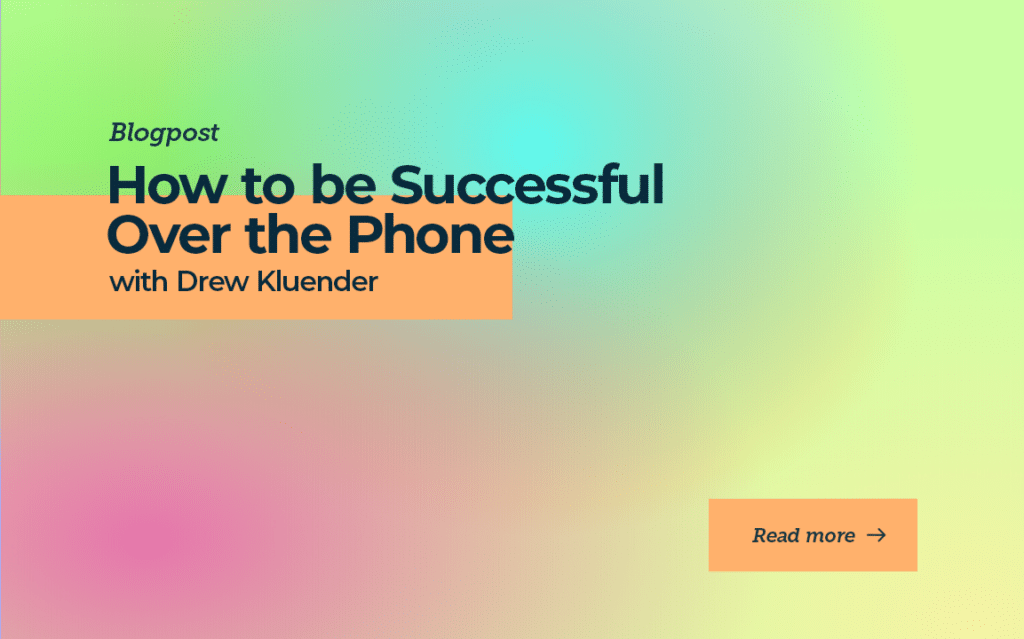How to be Successful Over the Phone with Drew Kluender

In the rapidly changing landscape of sales, it’s crucial to keep up-to-date with the best techniques for success.
On this episode, Collin Stewart sat down with Drew Kluender, Senior Inside Sales Rep at Orum, to discuss the nuanced art of sales, specifically over the phone. From building a foolproof cold-calling script to mastering the art of objection handling, this in-depth conversation offers a treasure trove of insights for SDRs at every stage of their career.
Cold Calling Scripts: A Framework for Success
Right from the get-go, Drew emphasizes the need for a well-crafted opener. It’s not about impressing your prospects with verbose language; it’s about making them pause to hear you out, even for just two minutes. “Do you have 2 minutes?” he suggests asking. These few words differentiate between an abruptly ended call and an open dialogue.
But let’s say your prospect is “busy,” a word we’re all too familiar with. Drew is a proponent of what he calls “leading with empathy.” This tactic opens up room to ask a pivotal question that could encourage the prospect to reassess their initial resistance. He advises, “Can I ask one question to see if it’s worth following up?”
It’s not just about breaking the ice; it’s about breaking down barriers.
Drew introduces an objection-handling strategy called the ‘Triple-A framework.’ This framework acknowledges the objection before deploying what Drew calls an “Accusation Audit.” This is a tactical move where you double down on the risk the prospect just identified but immediately counter it by adding value to the conversation.
The conversation also delves into the importance of crafting the right questions. In Drew’s opinion, asking situational questions can help you peel back layers of generic responses to reveal what the prospect needs or doesn’t even know they need.
Of course, a cold call is as good as a lost if it doesn’t culminate in a specific call-to-action (CTA). Drew is particular here: paint a vivid picture of the problem, sprinkle in some empathy, share success stories, and then present your solution in a way that makes the next step seem like the most logical move.
The Anatomy of a Cold Call Script
Most salespeople think a cold call script is completely scripted or ad-libbed. Drew Kluender offers a nuanced approach: the first half of the call should be scripted, setting the stage for an improvisational second half. It starts with a consistent opener, like a friendly “Good afternoon.” Then comes the permission-based opener or value proposition. Drew succinctly says, “I always go into why I’m calling.” Following this is your value proposition connected to positive business outcomes.
But what exactly is a value proposition? Drew advises that it should answer two critical questions: “What do you do?” and “What do I get?” He emphasizes that a value prop needs to connect to a tangible business outcome, increased revenue, decreased cost, or decreased risk to grab the prospect’s attention. “Your value prop should be so compelling that the prospect feels hooked,” Drew explains.
Asking the Right Questions
After you’ve hooked your prospect with a killer value proposition, Drew advises that you focus on asking questions to understand their current situation.
Questions should aim to dig deep into the prospect’s existing systems and processes. Once you understand their current situation, you can tailor your pitch more effectively. Drew even highlights a framework for asking open-ended questions, known as the Ted Williams question framework, which uses prompts like “Can you walk me through?” or “Can you expand upon that?”
Overcoming the “I’m Busy” Objection
The number one objection in cold calling? “I’m busy.” Drew’s strategy for this is straightforward: lead with empathy and offer to ask just one quick question. “Almost 95% of the time, people will say yes,” he notes.
Closing the Deal
Once you’ve gathered all this information, the next step is your call to action. Here, Drew warns against over-talking, stating, “Over-talking kills a lot more cold calls than under-talking.” Your final question should prompt an immediate response, aiming to schedule a follow-up call.

The Triple-A Framework and the Accusation Audit
Drew Kluender recommends the ‘Triple-A framework: Acknowledge, Add Value, and Ask a Question. Interestingly, a small addition to this could be an “Accusation Audit,” as mentioned by Collin Stewart. In essence, it is about:
- Acknowledging: The first step is showing empathy and understanding the objection. If a prospect says, “We don’t have the budget,” you could respond with, “I get it. Budgets are often tight.”
- Accusation Audit (Doubling Down): This part involves confirming the risk mentioned by the prospect. Continuing with the budget example, you might say, “No one wants to buy a tool that becomes shelfware the reps don’t use.”
- Adding Value: Here, you would introduce something new that adds value to the conversation. For example, “One thing I may add is folks in your exact situation often see a 2-3x increase in the volume of conversations, leading to more revenue.”
- Asking a Question (CTA): The Call-to-Action, where you nudge the prospect towards the next step. “Would you be open to discussing this further? I could schedule a call for Thursday at 3.”
Brush-Off vs. Legitimate Objections
Drew also categorizes objections into two types: Brush-off objections (“I’m busy,” “Send me an email”) and Legitimate objections (“We don’t have a budget,” “I’m not the decision-maker”).
A phrase like, “I know I caught you cold is the trick to dealing with brush-offs. Can I ask one question to see if it’s even worth following up?” It’s a soft yet effective way to get the conversation rolling.
The Number of Attempts
Drew says three attempts to handle objections in a single call is usually the limit. After that, the likelihood of converting that prospect decreases. “After the third call-to-action, it’s probably best to circle back later,” he says.
Learning from Multiple Experiences
Drew’s ability to adapt his objection-handling skills across various products sets him apart. He believes understanding the core structure of objection handling can help you adapt to any product. Essentially, it’s like plugging different variables into a math equation.
Navigating the Complexity of B2B Sales Conversations
In B2B sales, delivering a compelling demo is a nuanced endeavor. It’s not merely a showcase of your product’s capabilities; it’s a strategic initiative that should convey educational value to your prospective client. Often, sales teams take a feature-centric approach, concentrating on what the product can do. But a genuinely impactful demo aims to elevate the discussion by answering why and how a solution could make a difference in the prospect’s operations.
This value-driven approach establishes credibility and sets a foundation for a longer-term relationship, as the worst-case scenario leaves the prospect enriched with new knowledge.
Speaking of relationships, it’s crucial to remember that in a B2B setting, buying decisions are rarely made unilaterally.
You might initially be talking to someone who isn’t the ultimate decision-maker. However, that doesn’t mean you should take these conversations lightly. The first contact point often acts as a gatekeeper or internal advocate for your product. Your relationship with them should be strong enough that they feel compelled to champion your product or service higher up the chain of command. In practice, this could mean providing them with insights or data they can share to build a case for your solution.
It’s not about going above them; it’s about empowering them to be effective in their organizational context.
Strategic Timing and Skill Development for Long-Term Success
Timing is an underrated element in sales conversations. Imagine approaching a prospect who has just signed a year-long contract with one of your competitors. The chance of immediately flipping them to your service is nearly zero. However, this isn’t a dead end but rather an opportunity to plan strategically.
A savvy salesperson would schedule a follow-up discussion closer to the prospect’s contract renewal date, thus positioning their solution as a contender during the next evaluation period. This long-term view often pays dividends, demonstrating a keen understanding of the prospect’s business cycle and establishing a touchpoint for future engagement.
Building a pitch is not solely about discussing the features or benefits of what you’re selling. Instead, your pitch should revolve around positive business outcomes.
When approaching a prospect, especially one already partnered with a competitor, knowing the market well enough to articulate how your solution could deliver better results can be a game-changer. Whether it’s cost-saving, streamlining operations, or enhancing revenue, the focus should always be on the tangible value your product or service can bring to their business.
To perfect this entire intricate process, practice is essential. For many in sales, role-playing or practicing pitches may feel awkward or unnecessary, especially when dealing with the pressure of hitting quotas.
However, the benefits of rehearsing scenarios, particularly high-stakes or challenging ones, cannot be overstated. Simulation of these high-pressure situations can reveal gaps in your approach and clarify what needs improvement.

Strategy, Knowledge, Mindset, and Hidden Allies
Strategy Over Numbers
- What? Designate ‘call blocks’ for cold calls and ‘information gathering.’
- Why? Approach each day with a plan, not just a list of numbers to dial.
“Understanding the company landscape allows you to walk into a cold call not as an intruder but as a consultant.”
Knowledge Is Power
- Know The Landscape: Dive into the prospective client’s existing systems, processes, and pain points.
- The Benefit: It makes you more of a consultant than a salesperson during the pitch.
Mindset Matters
- Two Levers: Activity (what you can control) and Skill (what you cultivate).
- Outcome-Independence: Being resilient in the face of rejection can be empowering.
“Two levers control success in sales: activity and skill. Skill is a solitary journey, demanding proactive effort.”
Adjacent Titles: Hidden Allies
- Who? Managers or team leads who understand the decision-making process but don’t have purchasing power.
- Why Care? They can often introduce you to the decision-makers.
Continuous Skill Development
- How? Role-playing, shadowing top performers, and seeking feedback.
- Why? Cold calling is a nuanced art that requires constant refinement.
“By meshing a strategic approach with a strong mindset, cold calling turns into a nuanced art form.”
The Stoic Salesperson: Control and Acceptance
Collin emphasized, “You kind of control how you see the situation. You direct your actions accordingly.” This is a nod to the Stoic philosophy of focusing on what one can control and accepting what one can’t.
Drew added, “Willingly accept what is outside of your control. So if someone says no, that’s okay.” This form of emotional intelligence is about handling rejection and managing one’s emotional responses. It’s a mental model that can help reduce stress and increase resilience in a high-pressure role like sales.
Diagnosing Performance
When sales aren’t going as planned, Drew suggests a diagnostic approach: “So if you’re stuck, you got to figure out why. It’s either a skill thing or an activity thing.” This problem-solving method can be applied systematically, like a doctor diagnosing a patient.
Drew also advocates for seeking harsh, unfiltered feedback, even if it comes from the “meanest jerk” on the team. He believes that sometimes, the most valuable growth comes from challenging conversations, which can be a counterintuitive but effective way to improve.
The Tech Stack
Drew pointed out the importance of data quality, stating, “If you don’t have good data, you’re wasting your time.” This underscores the idea that technology is only as good as the data that feeds it, highlighting the growing importance of data analytics in sales.
Collin and Drew also discussed the cost-benefit analysis of various tools. Drew mentioned, “If you’re on a super tight budget, I’d go data dialer, hands down.” This challenges the notion that higher cost always equals higher quality, emphasizing the need to consider ROI when selecting tools.
The Quantitative Measure of Qualitative Work
Both Collin and Drew agreed on the importance of metrics in evaluating performance. Drew provided specific benchmarks for dials, connect rates, and conversions, reflecting the highly quantified nature of sales roles. However, Collin added a human element to the discussion, reminding us that “human labor is your biggest component… it is the best investment I’ve made to get good data to work on top.”
Burnout and Rest
And if you’ve been going at it, acknowledging the human need for rest and recovery, Collin mentioned, “Might be a vacation.” This suggests sustainable performance can’t be divorced from well-being, even in a high-performance role like sales.
Conclusion
We’ve journeyed through the intricate landscape of cold calling, from the initial “Hello” to the final call-to-action. We’ve unpacked Drew Kluender’s invaluable insights and Collin Stewart’s strategic contributions.
We’ve learned that cold calling is not just about scripts; it’s a nuanced blend of empathy, strategy, and continuous learning. We’ve also touched on the importance of data quality and personal well-being in achieving sustainable success.
So, as you pick up the phone for your next cold call, remember: you’re not just selling a product; you’re building a relationship, one call at a time.
NO TIME TO READ?
Listen On:



